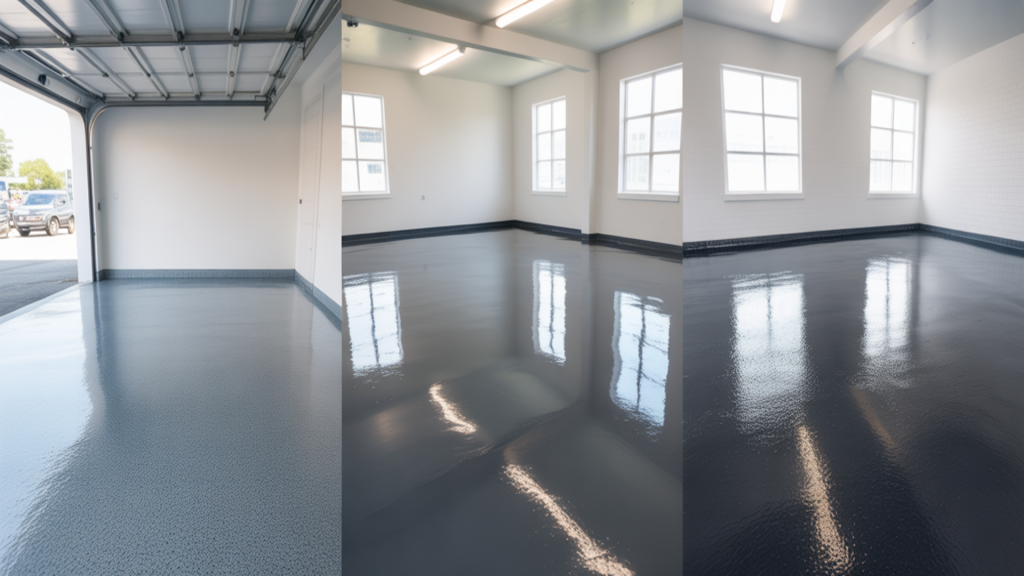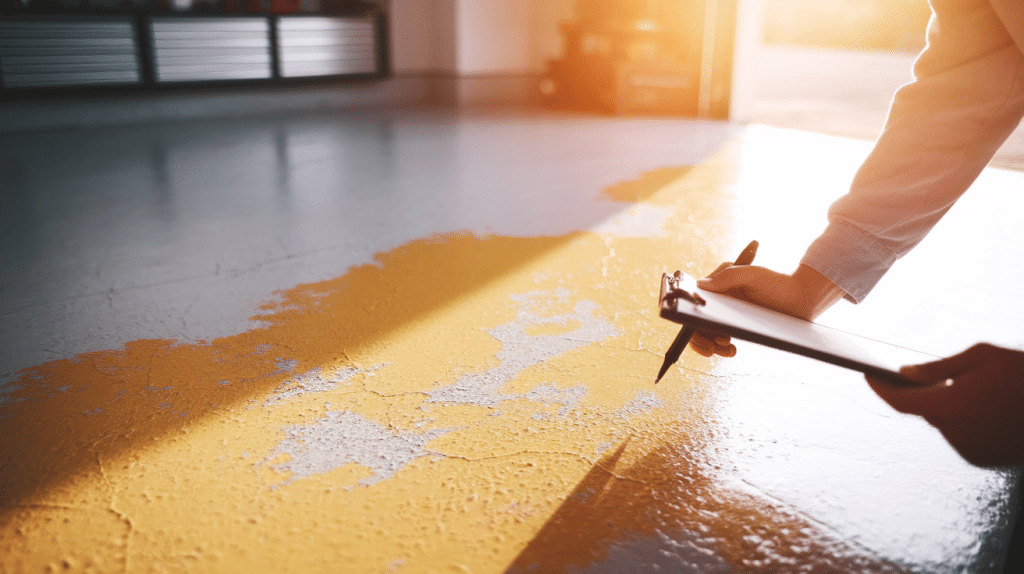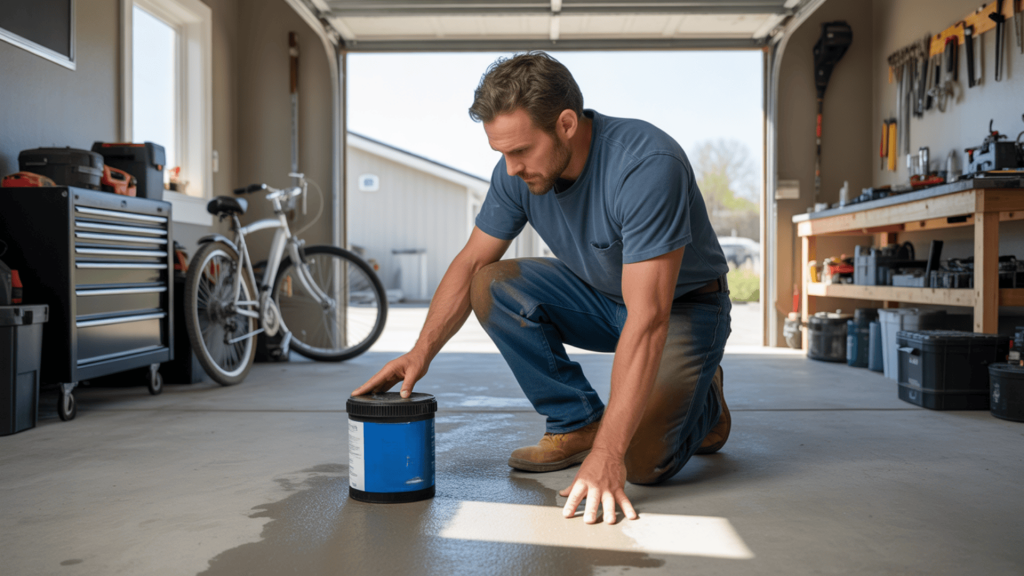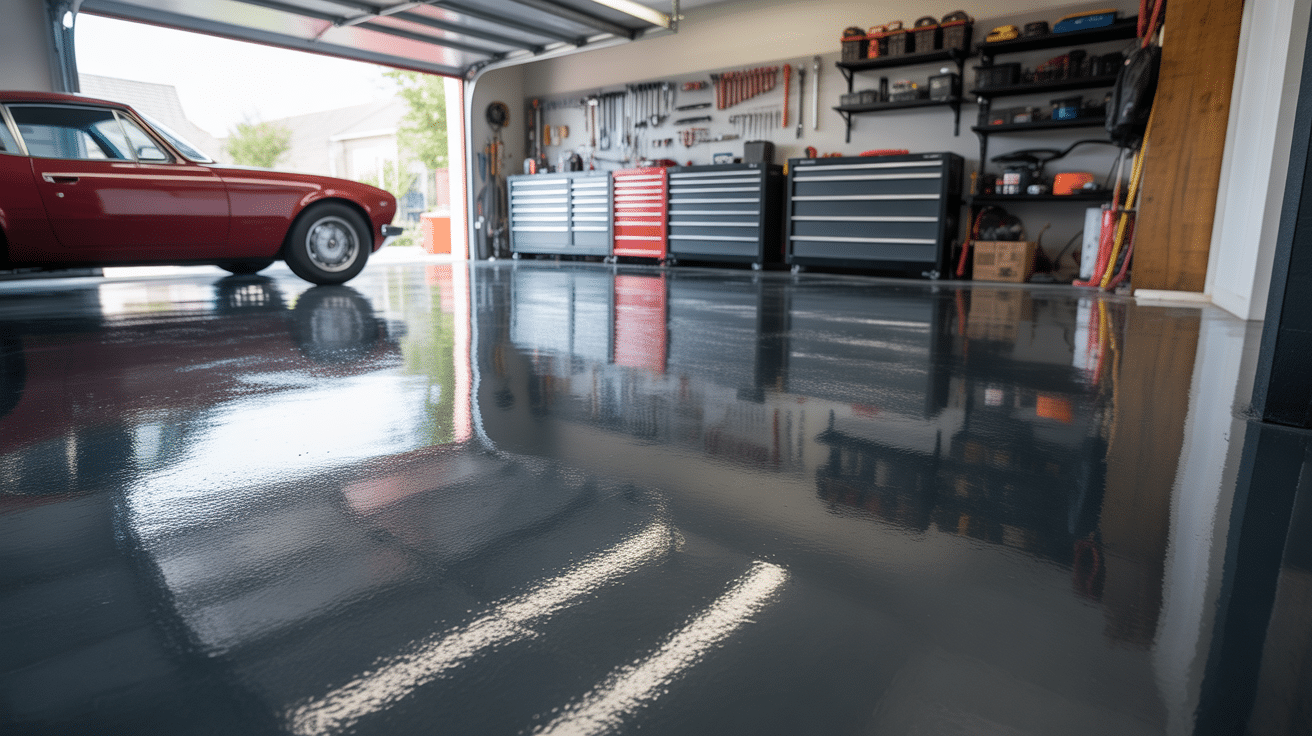Epoxy garage floors have become the go-to choice for homeowners who want their garages to look more like showrooms than storage spaces.
You’ve probably seen those glossy, colorful floors that make every tool and car look like it belongs in a magazine spread. But before you jump on the epoxy bandwagon, you need the full story about what you’re getting into.
This guide covers both the good and the not-so-good about epoxy floors, plus everything you should think about before making your decision.
We’ll walk through the real benefits, honest drawbacks, and practical considerations that matter most.
By the end, you’ll know whether epoxy is right for your garage, your budget, and your lifestyle. Let’s start with the basics and work our way through everything you need to know.
What Is an Epoxy Garage Floor?
Think of epoxy as a super-tough coating that goes over your concrete floor like armor plating.
It’s made from resin that hardens into a durable, glossy surface that can handle whatever your garage throws at it, from dropped tools to car fluids.
Most people choose epoxy for garages because it turns a boring concrete slab into something that looks professional and polished. It’s like giving your garage floor a complete makeover that’s built to last for years.
The coating bonds directly to your concrete, creating a seamless surface that’s much stronger than paint or basic sealers. You get a floor that not only looks great but also performs better than what you started with. It’s a permanent upgrade that changes how your whole garage feels and functions.
Types of Epoxy Coatings Used for Garage Flooring

Not all epoxy coatings are the same, and choosing the right type makes a big difference in your results. Here are the main options you’ll encounter when shopping for garage floor solutions.
| Type | Best For | Pros | Cons |
|---|---|---|---|
| Standard Epoxy Coatings | General use in garages, workshops, and homes | Seamless, stain-resistant, versatile for many applications | Can yellow over time, not as decorative as other options |
| Epoxy Flake Floors | Decorative garages, slip-prone areas | Enhanced visual appeal, slip resistance, hides imperfections | More complex applications may need periodic resealing |
| Epoxy Metallic Coatings | Showrooms, modern/luxury home garages | Unique marbled/pearlescent look, customizable, improves lighting | Higher cost, shows imperfections, requires a skilled installer |
| Polyaspartic Epoxy Coatings | Quick installations, chemical-prone garages | Rapid curing, high chemical resistance, UV stable | More expensive, can be slippery if not textured |
| Epoxy Resin Coatings | Commercial/industrial garages | Glossy, highly durable, easy to clean, and withstands heavy machinery | Professional installation recommended, can be costly |
| Color Flake Epoxy Coatings | Personalized, high-traffic garage floors | Customizable look, camouflages dirt, and durable surface | The application is multi-step, and flakes may loosen over time |
Key Benefits of Epoxy Garage Floors

Now, let’s look at why so many homeowners are choosing epoxy for their garage floors. These benefits explain the growing popularity and help you understand what you’re getting for your investment.
1. Exceptional Durability and Chemical Resistance
Epoxy floors can take a serious beating and keep looking good. They resist wear from heavy traffic, dropped tools, and even car tires without showing damage.
With proper care, a quality epoxy floor can last 10-20 years or more. That’s a lot longer than most other garage floor options you’ll find.
Oil changes, gas spills, and brake fluid don’t stand a chance against epoxy. The surface resists automotive fluids and solvents that would stain regular concrete permanently. When spills happen, they sit on top instead of soaking in.
2. Easy Maintenance and Cleaning
The smooth, non-porous surface means dust and dirt have nowhere to hide. Regular sweeping and mopping keep your floor looking like new with minimal effort.
Unlike concrete that harbors bacteria and mold in its pores, epoxy creates a barrier that’s naturally resistant to these problems. Your garage stays cleaner and healthier.
3. Aesthetic Appeal and Customization
Epoxy comes in tons of colors, patterns, and finishes to match your style. You can go glossy for maximum shine, matte for a subtle look, or metallic for something that really pops.
Want your floor to look like granite or quartz? Epoxy can mimic expensive materials at a fraction of the cost. The customization options are nearly endless.
4. Improved Safety and Visibility
Add slip-resistant particles to the epoxy, and you get better traction, even when the floor gets wet. This makes your garage safer for walking around tools and equipment.
The reflective surface also bounces light around better, making your garage brighter and easier to see in. Better lighting means fewer accidents and easier work.
5. Property Value and Cost-Effectiveness
A professional-looking epoxy floor makes your whole garage feel more finished and valuable. Potential buyers notice details like this when they’re evaluating your home.
While epoxy costs more upfront, it saves money in the long run. You won’t need to repair cracks, seal stains, or replace sections like you would with bare concrete. The durability means fewer maintenance headaches and lower costs over the years.
Potential Drawbacks of Epoxy Garage Floors

Being honest about the downsides is just as important as highlighting the benefits. Here are the main challenges you might face with epoxy garage floors:
1. Complex Installation and Higher Upfront Cost
Installing epoxy properly takes time and skill. The concrete needs extensive prep work, and the coating requires several days to cure completely.
Your garage will be out of commission for up to 5 days during the process. Plan ahead because you won’t be able to park cars or store items during installation.
Epoxy costs significantly more than simple sealers or basic tiles. The materials and labor add up quickly, especially if you want professional installation. Budget for both the coating itself and the prep work needed to make it stick properly.
2. Environmental Sensitivity and Installation Challenges
Epoxy doesn’t like moisture or big temperature swings. If your garage has humidity problems or gets very hot and cold, the coating might peel or crack.
Check your garage conditions carefully before committing. Problems with the foundation or moisture issues need fixing before epoxy goes down.
The installation process also creates strong chemical fumes that can be overwhelming. Good ventilation is absolutely necessary during application, and some people are sensitive to these odors.
3. Safety and Maintenance Concerns
Plain epoxy can be slippery when wet, which creates safety concerns in a garage environment. Spilled fluids or wet conditions can make walking treacherous.
Always ask for anti-slip additives if safety is a concern. The small extra cost is worth it to prevent accidents and injuries.
4. Appearance Issues Over Time
UV light from open garage doors can yellow or fade epoxy over time. This is especially noticeable with lighter colors and high-gloss finishes.
If your garage gets lots of sunlight, consider UV-stable topcoats or darker colors that hide fading better. Regular maintenance helps, too.
5. Difficult Repairs and Removal
When epoxy gets damaged, it’s hard to patch seamlessly. The repair usually shows up clearly against the surrounding area.
Removing epoxy completely is a major job that often requires professional equipment. Factor in these potential future costs when making your decision.
Epoxy Garage Floors vs. Alternatives
Here’s how epoxy stacks up against other popular garage floor options:
| Feature | Epoxy Garage Floor | Polyurea/Polyaspartic | Garage Tiles/Sealers |
|---|---|---|---|
| Durability | High | Very High | Moderate |
| Installation Time | Several days | 1 day | 1 day |
| UV Stability | Moderate | Excellent | Varies |
| Cost | Moderate-High | High | Low-Moderate |
| Customization | Excellent | Good | Good |
| Repairability | Difficult | Easier | Easy |
Is Epoxy Right for Your Garage? Key Considerations

Check your garage’s moisture levels, temperature swings, and how much sunlight it gets. These factors will determine whether epoxy is a good fit for your space.
Think about your budget for both installation and future maintenance. Remember that cheaper options might cost more over time if they need frequent repairs or replacements.
Decide if you want to tackle this as a DIY project or hire professionals. DIY can save money, but it requires skill and the right tools to get good results.
Consider how much downtime you can handle during installation and curing. Make arrangements for parking and storage during the process.
Expert Tips for Maximizing the Benefits
Getting the most from your epoxy floor starts with choosing a reputable, experienced installer who can show you examples of their previous work.
Always ask for slip-resistant additives and UV-stable topcoats to address the most common problem areas; these upgrades cost a little more upfront but prevent bigger issues down the road.
Keep up with regular maintenance by cleaning spills quickly and recoating when needed, as a little care goes a long way toward extending your floor’s lifespan and protecting your investment for years to come.
Conclusion
Epoxy garage floors offer outstanding durability, easy maintenance, and great looks that can tune up your space.
However, they also come with installation challenges and long-term considerations that you need to take into account.
The key is weighing these pros and cons against your specific garage conditions, budget, and expectations. What works perfectly for one homeowner might not be the best choice for another.
Before making your final decision, consider consulting a flooring expert who can assess your garage and give you personalized recommendations.
They can spot potential problems and help you choose the best solution for your situation.
Have you considered epoxy, or are you leaning toward a different option? Share your thoughts in the comments below; we’d love to hear about your garage flooring process.
Frequently Asked Questions
How Long Does Epoxy Floor Installation Take?
The complete process typically takes 3-5 days, including prep work, application, and full curing time before you can use your garage again.
Can I Install Epoxy Over Existing Floor Coatings?
No, existing coatings must be completely removed first; epoxy needs to bond directly to clean, prepared concrete for proper adhesion.
What Happens If My Epoxy Floor Gets Damaged?
Small chips can be touched up, but larger damage often requires professional repair that may not match perfectly with the surrounding area.

